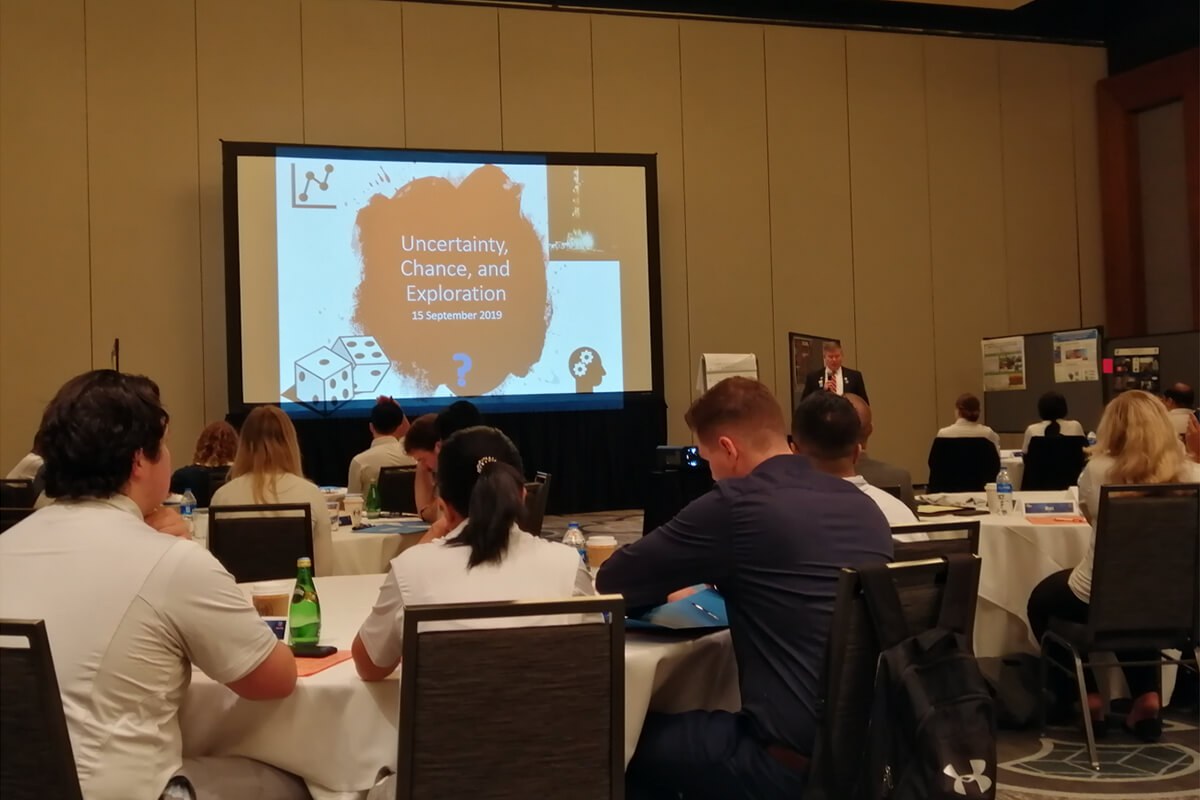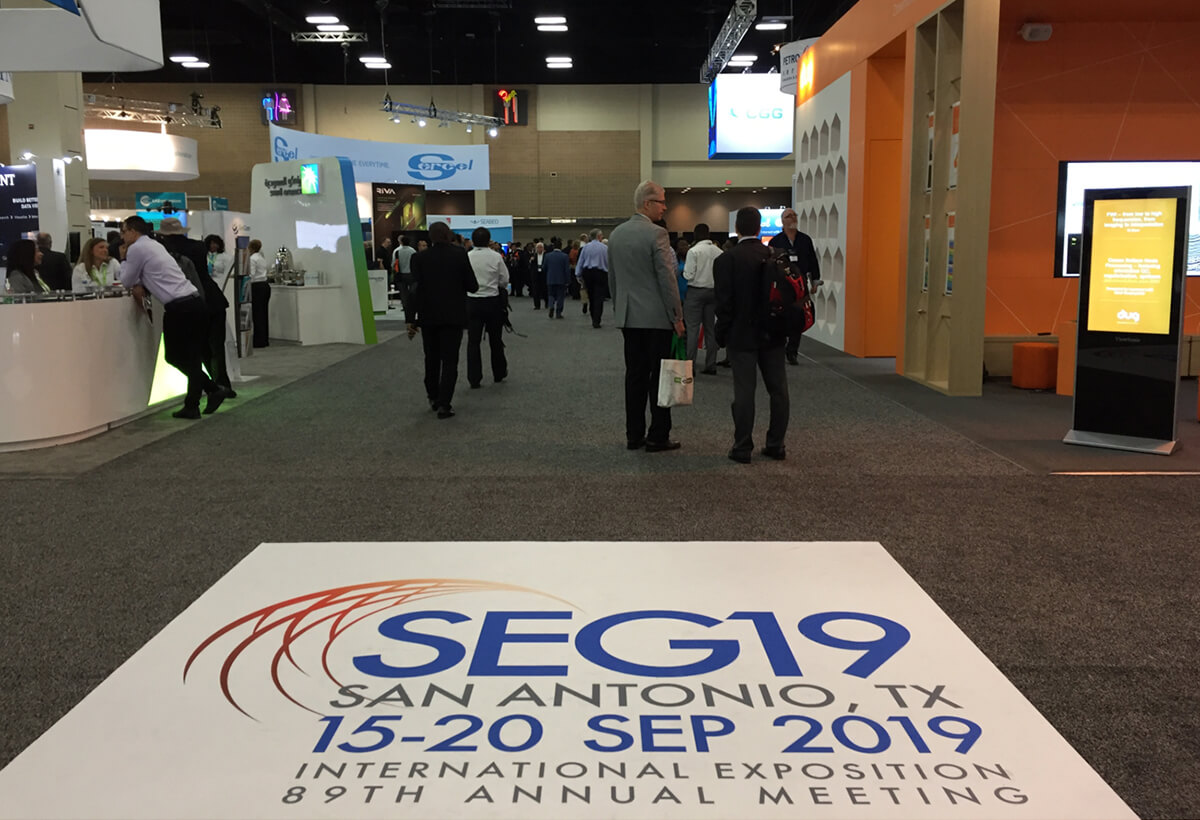Recently, I got a unique opportunity to participate in the Student Leadership Symposium (SLS) >organized jointly by Chevron and the Society of Exploration Geophysicists. Overall, 50 SEG Student Chapter officers were selected and received a travel grant to attend a 2-day workshop held on the weekend preceding the SEG Annual Meeting in San Antonio, TX, on September 15-20, 2019. During SLS, each SEG chapter representative presented the chapter’s activities, such as field camps, workshops, geoscientific lectures and many others.
I was representing the University of Calgary SEG student chapter, which is part of the University’s Student Exploration Geophysics Association (SEGA). SEGA is a joint group of 3 student chapters – SEG, EAGE and CSEG - at the University of Calgary. During the symposium, we had a chance to improve our leadership and teamwork skills through different activities supervised by Chevron representatives. Exercises helped us to determine our personalities, crucial for an effective collaboration in a team. David Bartel, Seismic Data Analysis Technology Development Team Lead with Chevron and SEG Foundation Director, explained to us the importance of uncertainty in geoscientific research and introduced the work environment and safety culture in Chevron. In addition, the company’s representatives provided us with valuable advice on how to succeed as a young geoscientists.
Moreover, we heard about available student SEG programs and initiatives. In addition to SLS, there are multiple ways to get involved and obtain support from the SEG to develop your skills, such as the Student Education Program (SEP), EVOLVE Program, Technical Travel Grants, scholarships, and many others. Additionally, young professionals may join the EPIC group (Emerging Professionals International Committee) to expand their professional network.
We had a unique opportunity to meet with SEG officers for an exclusive lunch, which was followed by an inspiring motivational talk by Ellen Vernotzy, General Manager, Frontier Exploration and Appraisal, Chevron Africa and Latin America E&P, who shared the exciting story of her career. One of the most absorbing parts was the student mentoring event, where industry professionals and academic researchers answered questions related to their work. We were fascinated to hear about career success stories from an exploration geophysicist, a software engineering team lead, a university professor, an SEG Foundation Board representative, and other experts.
Personally, SLS gave me a chance to meet ambitious geoscience students from all around the world. I have listened to presentations about multiple cultures and learned about activities organized by other chapters. It was an amazing place to make new friends which I hope to see at future SEG meetings.

Shortly after the SLS, we cheered our Canadian representatives in the SEG Challenge Bowl Finals, which took place on the first day of the SEG Annual Meeting. Challenge Bowl is a competition, during which students answer questions on topics ranging from geophysical methods and SEG history, to geology, mineralogy, or even astronomy. This year, Canada was represented by Jorge Nustes and Mauricio Reyes Canales from the University of Alberta, who placed 4th. After a fierce competition, the team from the National University of La Plata, Argentina, won the title for the second year in a row, followed by the teams from the King Fahd University of Petroleum & Minerals (KFUPM), and the University of Houston.
The SEG Annual Meeting itself was an incredible event. Every student should attend it to get a glimpse on the recent geophysical developments as well as current trends in the oil and gas industry. It is a very diverse conference, so everyone can find technical sessions and events that fit their professional interests. One of the most interesting places to visit was a vast area dedicated to the SEG organization, where you could spend memorable time and meet people actively involved in the SEG. I also wandered around the Student Lounge – a space where students gathered together to make new connections and talk to other young geoscientists.

I was very excited to meet in person SEG representatives – Kathryn Elkins, Johnna Yoder and Linda Ford, as well as Andrew Geary, host of the Seismic Soundoff podcast and EVOLVE Program Manager, and Rob Stewart – the SEG president. I believe the Annual Meeting is the only place where you can meet all the people contributing to SEG community in one place.
In short, the SEG Annual Meeting is an amazing conference with numerous technical talks – both during SEG technical sessions as well as at the Exhibition Hall. You could spend a whole day visiting the companies’ booths and learning about their services and research. SEG is characterized by the immense number of networking events. I have used these opportunities brought by the SEG and have met dozens of incredibly inspiring people, who shared their industry and academic experience. I also appreciated the opportunity to meet again with the ones based in Calgary, too!
I highly recommend an active participation in SEG (and other organizations) activities to all students in Geosciences. Extracurricular activities are worth the effort as they bring us closer to industry community. As graduate students, we tend to focus on our research, but we should remember that building one’s professional network by attending conferences is a huge help in our future careers, which cannot be substituted by even the most comprehensive study. So, students, take the opportunities, learn and have fun!
Biography
Paulina Wozniakowska is a PhD student at the University of Calgary. After graduating from AGH University of Science and Technology in Krakow in 2016, she worked as a junior analyst at a company specializing in microseismic monitoring until beginning her PhD at the University of Calgary. Her research focuses on induced seismicity as well as machine learning applications in seismology.












Share This CSEG Report